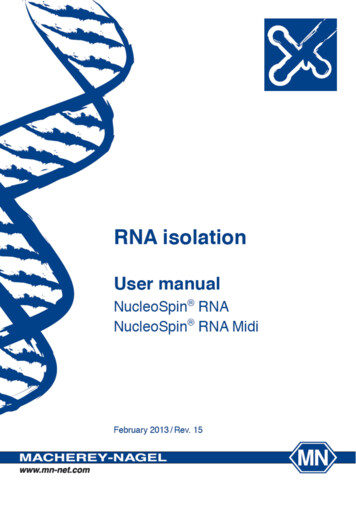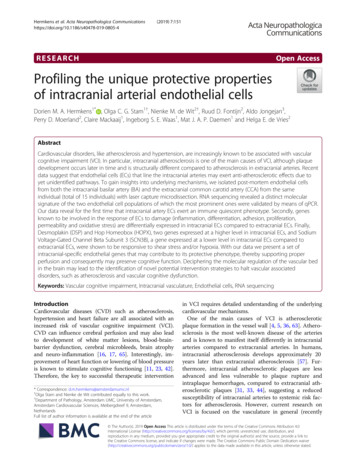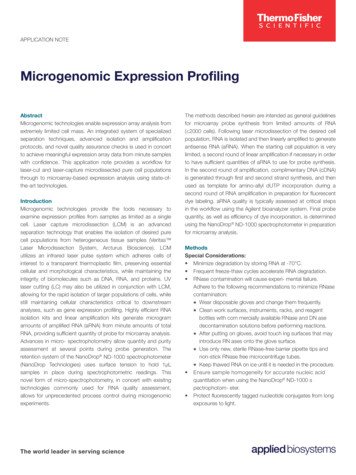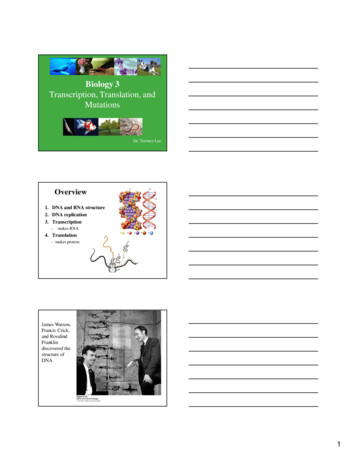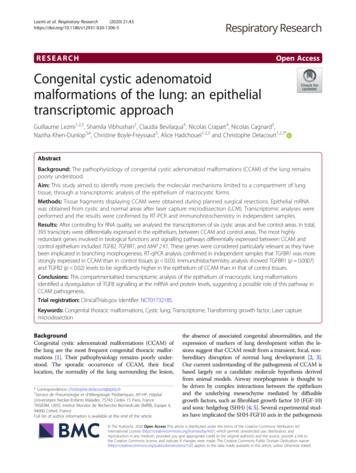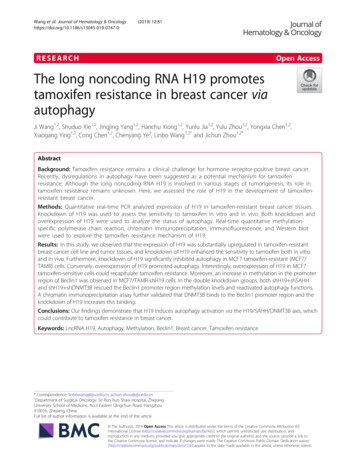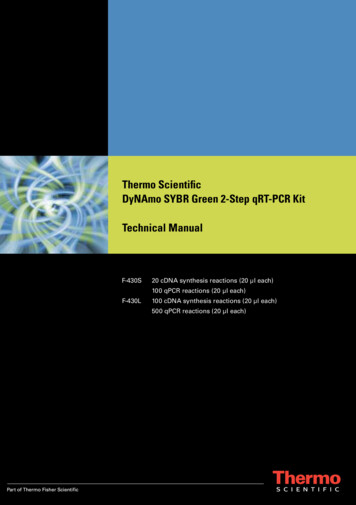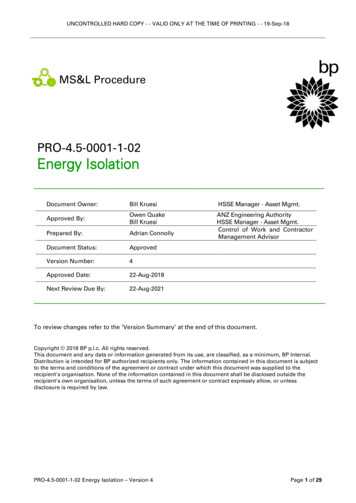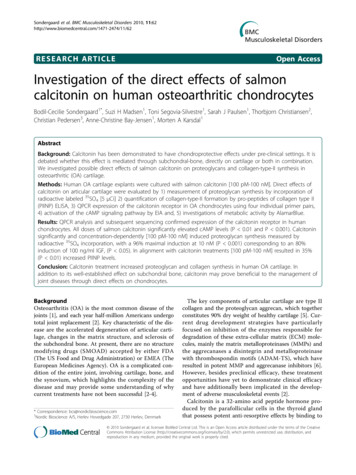
Transcription
IsolationmiRCURY RNA Isolation Kit BiofluidsInstruction manual v1.7#300112 and #300113November 2015
miRCURY RNA Isolation Kit - Biofluids · Instruction ManualTable of ContentsProduct summary . . . . . . . . . . . . . . . . . . . . . . . . . . . . . . . . . . . . . . . . . . . . . . . . . . . . . . . . .miRCURY RNA Isolation Kit – Biofluids contents . . . . . . . . . . . . . . . . . . . . . . . . . . . . . .Additional required materials, not supplied . . . . . . . . . . . . . . . . . . . . . . . . . . . . . . . . . . . .Product description . . . . . . . . . . . . . . . . . . . . . . . . . . . . . . . . . . . . . . . . . . . . . . . . . . . . . . . .Storage and product stability . . . . . . . . . . . . . . . . . . . . . . . . . . . . . . . . . . . . . . . . . . . . . . . .33346Protocol overview . . . . . . . . . . . . . . . . . . . . . . . . . . . . . . . . . . . . . . . . . . . . . . . . . . . . . . . . . 7Before starting the experiment . . . . . . . . . . . . . . . . . . . . . . . . . . . . . . . . . . . . . . . . . . . . . . 7Protocol & Notes . . . . . . . . . . . . . . . . . . . . . . . . . . . . . . . . . . . . . . . . . . . . . . . . . . . . . . . . . . 8General recommendations for working with biofluids . . . . . . . . . . . . . . . . . . . . . . . . . . . 8Notes prior to use . . . . . . . . . . . . . . . . . . . . . . . . . . . . . . . . . . . . . . . . . . . . . . . . . . . . . . . . . 9Section A. Standard protocol for RNA isolation . . . . . . . . . . . . . . . . . . . . . . . . . . . . . . 14Section B. RNA isolation using a vacuum manifold . . . . . . . . . . . . . . . . . . . . . . . . . . 17Tips and Troubleshooting . . . . . . . . . . . . . . . . . . . . . . . . . . . . . . . . . . . . . . . . . . . . . . . . . . 21Appendix A . . . . . . . . . . . . . . . . . . . . . . . . . . . . . . . . . . . . . . . . . . . . . . . . . . . . . . . . . . . . . . . 23Protocol for Optional On-column DNA Removal . . . . . . . . . . . . . . . . . . . . . . . . . . . . . . . 23Related products . . . . . . . . . . . . . . . . . . . . . . . . . . . . . . . . . . . . . . . . . . . . . . . . . . . . . . . . . 24Further reading . . . . . . . . . . . . . . . . . . . . . . . . . . . . . . . . . . . . . . . . . . . . . . . . . . . . . . . . . . 262
miRCURY RNA Isolation Kit - Biofluids · Instruction ManualProduct summarymiRCURY RNA Isolation Kit – Biofluids contentsThe miRCURY RNA Isolation Kit – Biofluids consists of the components described in Table 1.Table 1.Kit Components50 isolations10 isolationsLysis Solution BF13 mL13 mL5 mLProtein Precipitation Solution BF5 mLReaction buffer for rDNase7 mL7 mLrDNase, RNase-free (lyophilized)1 vial *1 vial *Wash Solution 1 BF10 mL10 mLWash Solution 2 BF (Concentrate)25 mL **6 mL ***RNase-Free Water13 mL13 mLmicroRNA Mini Spin Columns BF5010Collection Tubes (1.5 mL)5010Collection Tubes (2 mL)5010Collection Tubes with lid (2 mL)5010* For preparation of working solution see “Protocol & notes”. ** Add 100 mL 99% ethanol. *** Add 24 mL 99% ethanol.Note: In order to streamline manufacturing we have changed bottles from square to round and volumes have been modifiedslightly. Content is unchanged.Additional required materials, not supplied Benchtop microcentrifugePipette ( RNase-free tips)Vortexer99% ethanolIsopropanolProteinase K (optional)MS2 RNA (Highly recommended, for increased reproducibility) , Roche, cat. no. 10165948001RNA Spike-In Kit (#203203), optional for quality control of extraction efficiency3
miRCURY RNA Isolation Kit - Biofluids · Instruction ManualProduct descriptionExiqon’s miRCURY RNA Isolation Kit – Biofluids provides a rapid method for the isolationand purification of RNA from serum, plasma and other biofluids like cerebrospinal fluid orurine (for kit specifications see Table 2). The kit can be used for the purification of all RNAssmaller than 1000 nt, from mRNA and tRNA down to microRNA and small interfering RNA(siRNA). The purification is based on spin column chromatography using a proprietary resinas the separation matrix. Small RNAs are separated from other cellular components suchas proteins, without the use of phenol or chloroform in 40-70 minutes.The kit can be used to isolate high quality RNA in amounts sufficient for qPCR analysis usingthe miRCURY LNA Universal RT microRNA PCR system.The protocol consist of 5 simple steps (see also Figure 1):1. Biofluid components are lysed with the provided Lysis Solution2. Proteins are precipitated with the provided Protein Precipitation Solution3. Isopropanol is added to the collected supernatant and the solution is loaded to the columnwith an option for an on-column DNase digestion4. The solution is washed with Wash Solutions 1 and 25. The RNA is eluted with RNase free water4
miRCURY RNA Isolation Kit - Biofluids · Instruction ManualFigure 1. Protocol overview of the miRCURY RNA Isolation Kit – Biofluids.LysisPrecipitationSpinTransfer supernatantAdd Isopropanol and add to columnSpinWash 3 times with wash solutionsSpinElute RNA with RNase-free waterSpinPurified small RNAIn the first part of the RNA isolation process, membranized particles/cells are lysed using theprovided Lysis Solution (Figure 1). Proteins are precipitated using the precipitation solutionand isopropanol is then added to the transferred supernatant. This solution is loaded onto aspin-column. The resin binds RNA in a manner that depends on ionic concentrations. Thusonly the RNA will bind to the column, while the residual proteins will be removed in the flowthrough or retained on the top of the resin. The bound RNA is then washed with the providedWash Solution I and II in order to remove any remaining impurities, and the purified smallRNA is eluted with RNase free water.5
miRCURY RNA Isolation Kit - Biofluids · Instruction ManualImportant note - CautionsEnsure that a suitable lab coat, disposable gloves and protective goggles are worn andstandard safety precautions are followed when working with chemicals. GuanidineThiocyanate contained in the Lysis Solution BF and in Wash Solution 1 BF is an irritant. Formore information, please consult the appropriate Material Safety Data Sheets (MSDSs).Biofluids like serum or plasma of all human and animal subjects are considered potentiallyinfectious. All necessary precautions recommended by the appropriate authorities in thecountry of use should be taken when working with biofluids.Table 2.Kit SpecificationsColumn Binding Capacity200 μgMaximum Column Loading Volume800 μLSize of RNA Purifiedall RNA 1000 ntMaximum volume of Starting Material supported900 µL*Recommended volume of Starting Material200 µLElution volume20-50 µLTime to complete 10 Purifications40 min (70 min with optionalDNase digestion)* requires volume adjustment of Lysis Solution, Protein Precipitation Solution and Isopropanol. Sample should be loadedonto the column in aliquots. Each aliquot should be spun down before the next one is added.Storage and product stability Lyophilized rDNase should be stored at -20 C upon arrival. Storage of lyophilized rDNaseat room temperature is not critical.All other solutions should be kept tightly sealed and stored at room temperature. These reagentsshould remain stable for at least 6 months in their unopened containers.6
miRCURY RNA Isolation Kit - Biofluids · Instruction ManualProtocol overviewBefore starting the experimentWorking with RNARNases are very stable and robust enzymes that degrade RNA. Autoclaving solutions andglassware is not always sufficient to actively remove these enzymes. If working with RNA it isrecommended as a first step to create an RNase-free environment following the precautionsbelow. The RNA area should be located away from microbiological work stations Clean, disposable gloves should be worn at all times when handlingreagents, samples, pipettes, disposable tubes, etc. It is recommended that gloves are changed frequently to avoid contamination There should be designated solutions, tips, tubes, lab coats, pipettes, etc.for RNA work only All RNA solutions should be prepared using at least 0.05% DEPC-treatedautoclaved water or molecular biology grade nuclease-free water Clean all surfaces with commercially available RNasedecontamination solutions When working with purified RNA samples, ensure that they remain on iceCentrifugation ProceduresAll centrifugation steps in this protocol are carried out in a benchtop microcentrifuge atroom temperature. Various speeds are required for different steps, so please check yourmicrocentrifuge specifications to ensure that it is capable of the proper speeds. The correctrpm can be calculated using the formula:RPM RCF(1.118 x 10-5) (r)Where RCF required gravitational acceleration (relative centrifugal force in units of g); r radius of the rotor in cm; and RPM the number of revolutions per minute required to achievethe necessary g-force.7
miRCURY RNA Isolation Kit - Biofluids · Instruction ManualProtocol & notesGeneral recommendations for working with biofluidsSerum/plasmaWhen working with serum or plasma it is generally recommended not to work with hemolyzedsamples. Even traces of red blood cells in the serum or plasma may affect the microRNAprofile. It is recommended to follow recommendations found in the microRNA QC PCR ic/QC-PCR-Panel-Manual.pdf.After collection of serum or plasma it is important to centrifuge the sample in order to obtaincell free starting material. Centrifuge at no more than 3000 x g ( 2,000 RPM) for 5 minutesto pellet cells. Typically we rarely see more than 200 microRNAs present in any given nonhemolyzed serum or plasma sample (special cases where more microRNAs are found mayexist for certain samples).UrineGenerally, only small amounts of microRNAs are found in urine. However certain diseasestates give rise to an increased microRNA level in the urine. If patients/animals have beensubjected to toxicology experiments, increased amounts of microRNAs related to the injuryare typically found in the urine. When profiling microRNA from urine samples it is importantto ensure that the urine sample is free from cells in order to avoid contaminating the samplewith microRNAs from kidney or bladder cells. We therefore recommend that the startingmaterial should be centrifuged at no more than 3000 x g for 5 minutes. This should be doneprior to storage rather than immediately before isolation.Cerebrospinal fluid (CSF)CSF samples can be difficult to work with due to the very low levels of microRNAs incombination with the presence of PCR inhibitors. We rarely identif y more thanapproximately 30 microRNAs in CSF samples. However, certain disease states mayaffect the number of microRNAs that can be detected. When CSF samples are extractedit can be difficult to avoid contamination from adjacent tissue, so in order to obtain a cellfree starting material, centrifuge at no more than 3000 x g for 5 minutes to pellet cellsand debris.8
miRCURY RNA Isolation Kit - Biofluids · Instruction ManualExosomesWe recommend to use the miRCURY RNA Isolation kit - Biofluids for the RNA extractionfrom exosomes obtained from serum or plasma. For exosomes derived from other sources(like conditioned cell culture media, CSF or urine) we recommend the use of the miRCURY RNA Isolationkit - cell plant.Other biofluid samplesA number of other biofluids can be used with the miRCURY RNA Isolation Kit. The yieldmay vary significantly depending on organism, disease state and if the subject is medicated.The input amount of these biofluids has to be empirically determined and the amount of RNAto be used for the subsequent cDNA synthesis may have to be adjusted to avoid inhibition ofthe RT-reaction.Protocols for small RNA preparation from different biofluids follow on the next pages:Section A. Standard protocol for RNA isolation, please go to page 14Section B. RNA isolation using a vacuum manifold, please go to page 17NoteIt is important to work quickly during the whole procedure.Notes prior to useAmount of starting materialLysate preparations vary based on the starting material. Please ensure that the correct procedurefor preparing the lysate from your starting material is followed. However, the subsequentsteps are the same in all cases. If using less than 200 µL, we recommend filling up to 200µL with RNase-free water. The protocol can be scaled up to 300 µL starting material withoutany additional steps simply by adjusting the amounts of Lysis Solution, Protein PrecipitationSolution and Isopropanol in the steps prior to loading the samples onto the column.9
miRCURY RNA Isolation Kit - Biofluids · Instruction ManualTable 3.Serum/plasmaUrineCSFOther biofluids*Human samples200 μL200 μL200 μL200 μLRodent samples50 μL**200 μLNot tested50 μL**RNA eluate input to 20µLcDNA synthesis reaction***4 μL4 μL8 μL4 μL*We always recommend optimizing input to sample preparation and cDNA synthesis, by investigating inhibition, since amountof inhibitors and microRNA levels vary between biofluids and organisms.** When biofluid volume is less than 200µL, we recommend filling up to 200µL with RNase-free water.*** For subsequent analysis using the miRCURY LNA Universal RT microRNA PCR system.Recommended volumes of biofluids including input to the downstream cDNA synthesis are listedin Table 3. These volumes are just guidelines, and optimum volumes should be determined ineach individual case. The kit components allow extraction of RNA from up to 900 µL biofluid.After adjusting the amounts of Lysis Solution, Protein Precipitation Solution and Isopropanol,the sample is then loaded on the column in aliquots followed by a centrifugation step.Elution volumeThe recommended elution volume is 50 µL. This volume is adapted to fit into Exiqon’s PCRprotocols. When extracting exosomal RNA from serum or plasma we recommend to elute in100 µL. For other applications, a more concentrated eluate may be desirable. Reducing theelution volume to the minimum of 20 µL specifically allows concentrating small RNA whilelarger RNA is retained on the column.Treatment prior to RNA isolationThe RNA composition from biofluids will give different results in downstream analysis dependingon the treatment of the biofluid prior to RNA isolation. Please ensure that sample acquisitionconditions and specimen pre-treatment are controlled and defined, e.g. if interested in a cellfree specimen centrifuge with 3000 x g ( 2,000 RPM) for 5 minutes in order to pellet debrisand cells. Transfer the supernatant into a new vial prior to use or storage.10
miRCURY RNA Isolation Kit - Biofluids · Instruction ManualAvoid heparinFor downstream qPCR we recommend the use of serum or citrate /EDTA plasma anddiscourage using Heparin plasma. RNA isolated from Heparin plasma will significantly reducePCR performance.CentrifugationAll centrifugation steps are carried out in a benchtop microcentrifuge at 11,000 x g exceptwhere noted. A variable speed centrifuge should be used for maximum kit performance. Ifa variable speed centrifuge is not available a fixed speed centrifuge can be used, howeverreduced yields may be observed. All centrifugation steps are performed at room temperature.Working temperatureEnsure that all solutions are at room temperature (18-25 C) prior to use.Preparation of Wash Solution 2 BFPrepare a working concentration of the Wash Solution 2 BF by adding 100 mL of 99% ethanol(provided by the user) to the supplied bottle containing the concentrated Wash Solution 2 BF(or 24mL if using the 10 prep kit). The label on the bottle has a box that may be checked toindicate that the ethanol has been added.Preparation of rDNase solutionPrepare a working solution of rDNase by adding 3 mL rDNase Buffer to the rDNase vial.Incubate at room temperature for 1 min. Swirl gently to redissolve completely but avoidvigorous mixing to minimize mechanical shearing which could affect enzyme quality. Aliquotand store at -20 C for later use. Avoid repeated freeze thawing. The working solution is stablefor at least 6 months.Optional Proteinase K treatmentAn optional Proteinase K treatment (just prior to step 2) can improve yield and quality for somelow quality samples. Add Proteinase K in a final concentration of 1-3 µg/µL to the sample.Incubate 10 min at 37 C. Then proceed to step 2 of the protocol and add Lysis Solution BF.11
miRCURY RNA Isolation Kit - Biofluids · Instruction ManualFor subsequent qPCR analysis add carrierTo minimize the technical variation between replicates in downstream PCR analysis we highlyrecommend adding:- 1µg MS2 RNA or yeast tRNA (not included) per sample to the Lysis Solution BF prior to step 1 ofthe protocol. Vortex/Mix to ensure homogenous distribution. For other downstram applicationsthan the miRCURY LNA Universal RT microRNA PCR make sure the use of carrier does notinterfere with the intended use. If RNA is to be used for Next Gen Sequencing, we recommendto use an RNA free carrier like glycogen (RNA grade). Add 2 µg per sample to the Lysis solutionBF prior to step 1 of the protocol. Vortex/Mix to ensure homogenous distribution.For subsequent qPCR analysis add RNA spike-insTo monitor the RNA isolation via miRCURY LNA Universal RT microRNA PCR we recommendadding:- 1µL Exiqon RNA spike-in mix (UniSp2, UniSp4 and UniSp5, product number #203203) persample (not included) to the Lysis Solution BF prior to step 1 of the protocol. Vortex/Mix toensure homogenous distribution.Determination of yield is usually not possible by spectrophotometric reading.We therefore recommend using biofluid input amount in the PCR reaction as ameasure, combined with subsequent quantification of spike-ins (if used).In order to identify the optimum sample input as well as cDNA input, it is recommended toinvestigate how much RNA can be used in the cDNA without inhibiting the RT reaction. If toomuch RNA is added to the RT reaction, it results in non-linear behavior of microRNAs and oftenalso a poorer call rate, due to co-extraction of inhibitors during the sample preparation. Whenisolating RNA from different biofluids for qPCR we recommend performing an upfront dilutioncurve ideally covering 4-6 data points in triplicate to verify the validity of the quantification.This dilution curve should cover the input amount in the cDNA reaction. An example of sucha linearity analysis of a dilution curve is given in Figure 2. The input amount related to datapoint 2 would in this case allow the measurement of both samples within their linear range.12
miRCURY RNA Isolation Kit - Biofluids · Instruction ManualFigure 2. In order to optimize qPCR performance, it is recommended to perform a dilution curve covering different RNAinputs to the cDNA synthesis to reveal at what input volume inhibitors affect qPCR performance.38Sample ASample BCq values3736PCR Inhibition3534333201248Input amount (µL)RNA yieldSince only small RNA is extracted, quantification by optical spectrophotometry or Nanodropis not possible. We recommend that the RNA used in downstream applications are based onsample input.13
miRCURY RNA Isolation Kit - Biofluids · Instruction ManualSection A. Standard protocol for RNA isolationNotes prior to useBefore getting started please ensure that isopropanol is available and that ethanol has beenadded to Wash Solution 2 BF and that rDNase has been resuspended in rDNase reactionbuffer or that the respective rDNase aliquot is at hand. Make sure that the centrifuge is runat room temperature.Standard protocolfor RNA isolationStep 1Sample preparation14After thawing, samples should be centrifuged at 3000 x g for 5 min topellet any debris and insoluble components (make sure to use excesssample in order to secure sufficient supernatant for step 2). Thisprotocol is designed for human serum and plasma. Samples from otherorganisms may contain more/less inhibitors that will affect downstreamapplications. For rodent samples, we generally recommend using lessstarting material (50µL) and top up with water to 200µL.microRNA content may vary significantly between sample types.Recommended starting volume may have to be adjusted. In order toreduce the effect of inhibitors/nucleases the starting material should becentrifuged at no more than 3000 x g for 5 minutes. This should be doneprior to storage rather than immediately prior to isolation. Omitting thisclearance step can affect subsequent PCR analysis (use excess samplein order to secure sufficient supernatant for step 2).In order to reduce the effect of inhibitors/nucleases the starting materialshould be centrifuged at no more than 3000 x g for 5 minutes. This shouldbe done prior to storage rather than immediately prior to isolation.Omitting this clearance step can affect PCR detection (use excess samplein order to secure sufficient supernatant for step 2).continued on next page.
miRCURY RNA Isolation Kit - Biofluids · Instruction ManualStep 1Sample preparationcontinued.Step 2LysisOther biofluidsOptimum input volume needs to be empirically determined to ensurehigh RNA yield and prevent inhibition of downstream PCR applications.Transfer 200 µL supernatant from step 1 to new tube and add 60 µLLysis solution BFVortex for 5 sec.Incubate for 3 min at room temperature.Recommendation: For downstream PCR analysis, add 1 µL RNA Spike-intemplate mixture (miRCURY LNA Universal RT microRNA PCR, RNASpike-in kit) and 1µg carrier-RNA/60µL Lysis Solution BF.Add 20 μL of Protein Precipitation Solution BF.Vortex for 5 sec.Incubate for 1 min at room temperature.Centrifuge for 3 min at 11,000 x g.Step 4 Transfer supernatantTransfer the clear supernatant into a new collection tube (2 mL, with lid).Step 5 Adjust bindingconditionsAdd 270 µL Isopropanol.Vortex for 5 sec.Step 6* Load columnPlace a microRNA Mini Spin Column BF in a collection tubeand load sample onto the column.Incubate for 2 min at room temperature.Centrifuge for 30 sec at 11,000 x g.Discard flow-through and place column backinto the collection tube.Standard protocolfor RNA isolationStep 3 Protein PrecipitationNote: if more than 300 µL sample was used repeat this stepuntil all material is loaded.* If DNA contamination is a problem, please perform an on-column DNase treatment as described in Appendix A.15
miRCURY RNA Isolation Kit - Biofluids · Instruction ManualStep 7a Wash and dryAdd 100 µL Wash Solution 1 BF to the microRNA spin column BF.Centrifuge for 30 sec at 11,000 x g.Discard flow-through and place column back into the collection tube.Step 7b Wash and dryAdd 700 µL Wash Solution 2 BF to the microRNA spin column BF.Centrifuge for 30 sec at 11,000 x g.Discard flow-through and place column back into the collection tube.Step 7c Wash and dryAdd 250 µL Wash Solution 2 BF to the microRNA spin column BF.Centrifuge for 2 min at 11,000 x g to dry the membrane completely.Step 8 ElutePlace the microRNA spin column BF in a new collection tube (1.5 mL).Add 50 µL RNase free H2O directly onto the membrane of the microRNAspin column BF.Incubate for 1 min at room temperature.Close the lid and centrifuge for 1 min at 11,000 x g.Standard protocolfor RNA isolationNote: the recommended 50 µL elution volume is ideal for use with Exiqon’sUniversal cDNA Synthesis Kit. However when isolating exosomal RNA werecommend to elute in 100 µl in order to maximize yield, the elution canbe done in two steps eluting with half of the recommended total volumeeach.Step 9 StorageThe purified RNA sample may be stored at –20 C for a few days. It isrecommended to keep the samples at –70 C for long term storage.NoteFor downstream qPCR analysis we recommend using the PCR manual for serum/plasma andother biofluid samples, using the recommended cDNA input from Table 3.16
miRCURY RNA Isolation Kit - Biofluids · Instruction ManualSection B. RNA isolation using a vacuum manifoldNotes prior to useThis is a general protocol intended for use with commercially available vacuum manifolds. Thevacuum system should enable a vacuum of between -800 to -900 mbar. In some cases additionalextension tubes or adaptors may be necessary. For more specific questions, please contact thevendor of your vacuum manifold.Lysis Solution BF and Wash Solution 1 BF contain Guanidine thiocyanate. Do not treat waste/flow through with acid/bleach. Acidic conditions will release toxic fumes.Before getting started please ensure that isopropanol is available, that ethanol has been added toWash Solution 2 BF and that rDNase has been resuspended in rDNase reaction buffer or that therespective rDNase aliquot is at hand. Make sure that the centrifuge is run at room temperature.Step 1Sample preparationSerum/plasmaAfter thawing, samples should be centrifuged at 3000 x g for 5 min topellet any debris and insoluble components (make sure to use excesssample in order to secure sufficient supernatant for step 2). This protocolis designed for human serum and plasma. Samples from other organismsmay contain more/less inhibitors that will affect downstream applications.For rodent samples we generally recommend to using starting material(50µL) and top up with water to 200µL.Isolation using avacuum manifoldCell free urinemicroRNA content may vary significantly between sample types.Recommended starting volume may have to be adjusted. In order toreduce the effect of inhibitors/nucleases the starting material shouldbe centrifuged at no more than 3000 x g for 5 minutes. This shouldbe done prior to storage rather than immediately prior to isolation.Omitting this clearance step can affect subsequent PCR analysis (useexcess sample in order to secure sufficient supernatant for step 2).continued on next page.17
miRCURY RNA Isolation Kit - Biofluids · Instruction ManualStep 1Sample preparationcontinued.Cerebrospinal fluidIn order to reduce the effect of inhibitors/nucleases the starting materialshould be centrifuged at no more than 3000 x g for 5 minutes. This shouldbe done prior to storage rather than immediately prior to isolation.Omitting this clearance step can affect PCR detection (use excess samplein order to secure sufficient supernatant for step 2).Other biofluidsOptimum input volume needs to be empirically determined to ensurehigh RNA yield and prevent inhibition of downstream PCR applications.Step 2 LysisTransfer 200 µL supernatant from step 1 to new tube and add 60 µLLysis solution BF.Vortex for 5 sec.Incubate for 3 min at room temperature.Isolation using avacuum manifoldRecommendation: For downstream PCR analysis, add 1 µL RNA Spike-intemplate mixture (miRCURY LNA Universal RT microRNA PCR, RNASpike-in kit) and 1µg carrier-RNA/60µL Lysis Solution BF.18Step 3 Protein PrecipitationAdd 20 μL of Protein Precipitation Solution BF.Vortex for 5 sec.Incubate for 1 min at room temperature.Centrifuge for 3 min at 11,000 x g.Step 4 Transfer supernatantTransfer the clear supernatant into a new collection tube (2 mL, with lid).Step 5 Adjust bindingconditionsAdd 270 µL Isopropanol.Vortex for 5 sec.
miRCURY RNA Isolation Kit - Biofluids · Instruction ManualStep 6* Load columnConnect microRNA Mini Spin Column BF to the vacuum manifoldallowing vacuum suction. Make sure unused manifold positions aresealed (no vacuum applied).Load sample to the column (no vacuum applied). Incubate for 2 min atroom temperature.Apply vacuum. When all columns stop dripping switch off the vacuumand ventilate the vacuum device.Note: If more than 300 µL sample was used repeat the loading stepuntil all material is loaded.Add 100 µL Wash Solution 1 BF to the microRNA spin column BF(no vacuum applied).Switch on vacuum. When all columns stop dripping switch off the vacuumand ventilate the vacuum device.Step 7b Wash and dryAdd 700 µL Wash Solution 2 BF to the microRNA spin column BF(no vacuum applied).Switch on vacuum. When all columns stop dripping switch off the vacuumand ventilate the vacuum device.Step 7c Wash and dryAdd 250 µL Wash Solution 2 BF to the microRNA spin column BF(no vacuum applied).Switch on vacuum. When all columns stopped dripping switch off thevacuum and ventilate the vacuum device.Transfer microRNA Mini Spin Column BF to a collection tube (2mL).Centrifuge for 2 min at 11,000 x g to dry the membrane completely.* If DNA contamination is a problem, please perform an on column DNase treatment as described in Appendix A.Isolation using avacuum manifoldStep 7a Wash and dry19
miRCURY RNA Isolation Kit - Biofluids · Instruction ManualStep 8 ElutePlace the microRNA spin column BF in a new collection tube (1.5 mL).Add 50 µL RNase-free H2O directly onto the membrane of the microRNAspin column BF.Incubate for 1 min at room temperature.Close the lid and centrifuge for 1 min at 11,000 x g.Note: the recommended 50 µL elution volume is ideal for use with Exiqon’sUniversal cDNA Synthesis Kit. However when isolating exosomal RNAwe recommend to elute in 100 µl In order to maximize yield the elutioncan be done in two steps eluting with half of the recommended totalvolume each.Step 9 StorageThe purified RNA sample may be stored at –20 C for a few days. It isrecommended to keep the samples at –70 C for long term storage.NoteIsolation using avacuum manifoldFor downstream qPCR analysis we recomm
miRCURY RNA Isolation Kit - Biofluids· Instruction Manual Product description Exiqon's miRCURY RNA Isolation Kit - Biofluids provides a rapid method for the isolation and purification of RNA from serum, plasma and other biofluids like cerebrospinal fluid or urine (for kit specifications see Table 2) .
